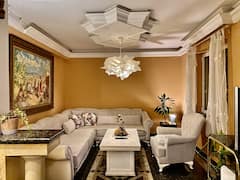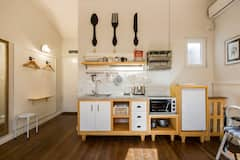Tracing the history and its trends in Belgrade through architecture is rather difficult, due to frequent disasters that were imposed on the Serbian capital and nation. Thankfully, such a fate skipped the Residence of Princess Ljubica, which was briefly the home of the Serbian ruling family before its transformation into an official building. Today, the residence is an exceptional museum, which exhibits civil public and private rooms during the fast transformation of Serbia from the Turkish province into a modern European state in the 19th century.
About the Residence of Princess Ljubica

The Residence of Princess Ljubica is an architectural gem of the Serbian capital, erected between 1829 and 1831 by Prince Milos Obrenovic, the ruler of the principality of Serbia. At that time, Serbia still wasn’t completely free of the Turkish Empire, whose troops were situated in the nearby Kalemegdan Fortress. We could but guess that Prince Milos erected the residence within their sight to taunt them.
Prince Milos Obrenovic, however, decided very soon to commission his personal residence in the Topcider Park (the Residence of Prince Milos), leaving to his wife Ljubica and sons Milan and Mihailo to manage and use the residence, thus its name.
Although basically featuring the Ottoman building style, new European influences also played their part in the construction of the building. It features two upper floors and a basement, with a myriad of private and several public rooms. The Princess Ljubica Residence kept its original purpose until 1842, when the Obrenovic family was temporarily forced into exile, and from then on, this magnificent mansion was used as an official building, housing the Lyceum, court, school, and so on.
"The Interiors of the 19th century homes" exhibition

As you advance through various sections of the mansion, you’ll become familiarized with the history of Belgrade in the 19th century, the ruling Obrenovic dynasty, and swift social development of the Serbian state. In the drawing rooms and personal studies, you’ll see portraits of the members of the Obrenovic family, drawings that illustrate architectural transformation of Belgrade from a Turkish hamlet into a modern capital, and find out how members of the higher social classes lived.
Take this section’s photo as a reference. Queen Natalia’s Drawing Room is equipped with highly elegant and pricey furniture fabricated by prestigious European manufacturers. It features the Second Empire Style, which was in vogue in the second half of the 19th century. Portraits of Queen Natalia and her husband, King Milan, are attached. During Milan’s reign (1872 – 1889), Serbia finally became an independent state, while Natalia proved herself as a great benefactor to the Serbian people and various institutions.
Before the transformation, everyday life used to be influenced exclusively by the Ottoman way of living (the first half of the 19th century). The Princess Ljubica Residence showcases the Turkish rooms, which were changed according to present needs. A reception room during the day, for example, was transformed into a bedroom during the night. The brazier always assumed the centre of the room, equally distributing the warmth, while wooden sets for sitting and lying were distributed against the walls. Carpets and furniture featured Oriental ornamental decoration.
As Serbia succeeded in achieving its limited autonomy from the Turkish Empire (1815 – 1830), the Serbs from Europe started to migrate to their homeland, bringing new movements and comprehensive changes with them. It is how initially the Biedermeier style, then Baroque Revival, Rococo Revival and other popular movements of the 19th century gradually entered the homes of the Serbs.
Highlights of the Princess Ljubica Residence

Princess Ljubica’s Room (refer to the related photo) is an excellent example of the Ottoman Balkan style. Spacious and richly decorated by the standards of that time, it was connected with a small bathroom, which used to be a luxury back then that only the upper social classes could afford. Installing a Turkish Hammam, a steam room, in 1836 next to the room, was intended to additionally strengthen the Obrenovic family’s status as much as improve the quality of living. Related portraits depict Prince Milos to the left, Princess Ljubica with their older son Milan (who died before becoming the chief prince) in the centre, and future Prince Mihailo Obrenovic.
Throughout the ground and first floors, the Divanhane Rooms occupy central positions of the great halls, featuring the garden views. These semicircular rooms were intended for public gatherings, and while the Divanhane of the ground floor were used for the public receptions, the large and the small Divanhanes (windowed terraces) on the upper floor were used for more intimate gatherings. Simple, yet elegantly decorated, the Divanhanes featured semicircular sitting sets, flamboyant carpets and small tables.
The Small Divanhane, connected by a small corridor with the grand hall of the first floor, was a private chamber where Prince Milos and Princess Ljubica had their discussions. Since it is directed toward the main street (refer to the uppermost photo), they were able to observe unnoticed what was going on there.
You might be interested in these Airbnbs!
This still isn’t everything
Princess Ljubica Residence also organizes temporary exhibitions in the basement on occasion, as well as regular receptions with the princess in a Divanhane, played by a curator of the Belgrade Museums. Dressed in period costume, Princess Ljubica speaks about the way of living in the 19th century, her peculiar relationship with Prince Milos and other curiosities.
The museum operates every day except on Monday; the price for the permanent exhibition is 1.50 EUR (1.60 USD), while having a coffee with the princess, served with Turkish delicacies, costs 5.70 EUR (6.20 USD).
History
Get Trip101 in your inbox
Unsubscribe in one click. See our Privacy Policy for more information on how we use your data























Create an account to